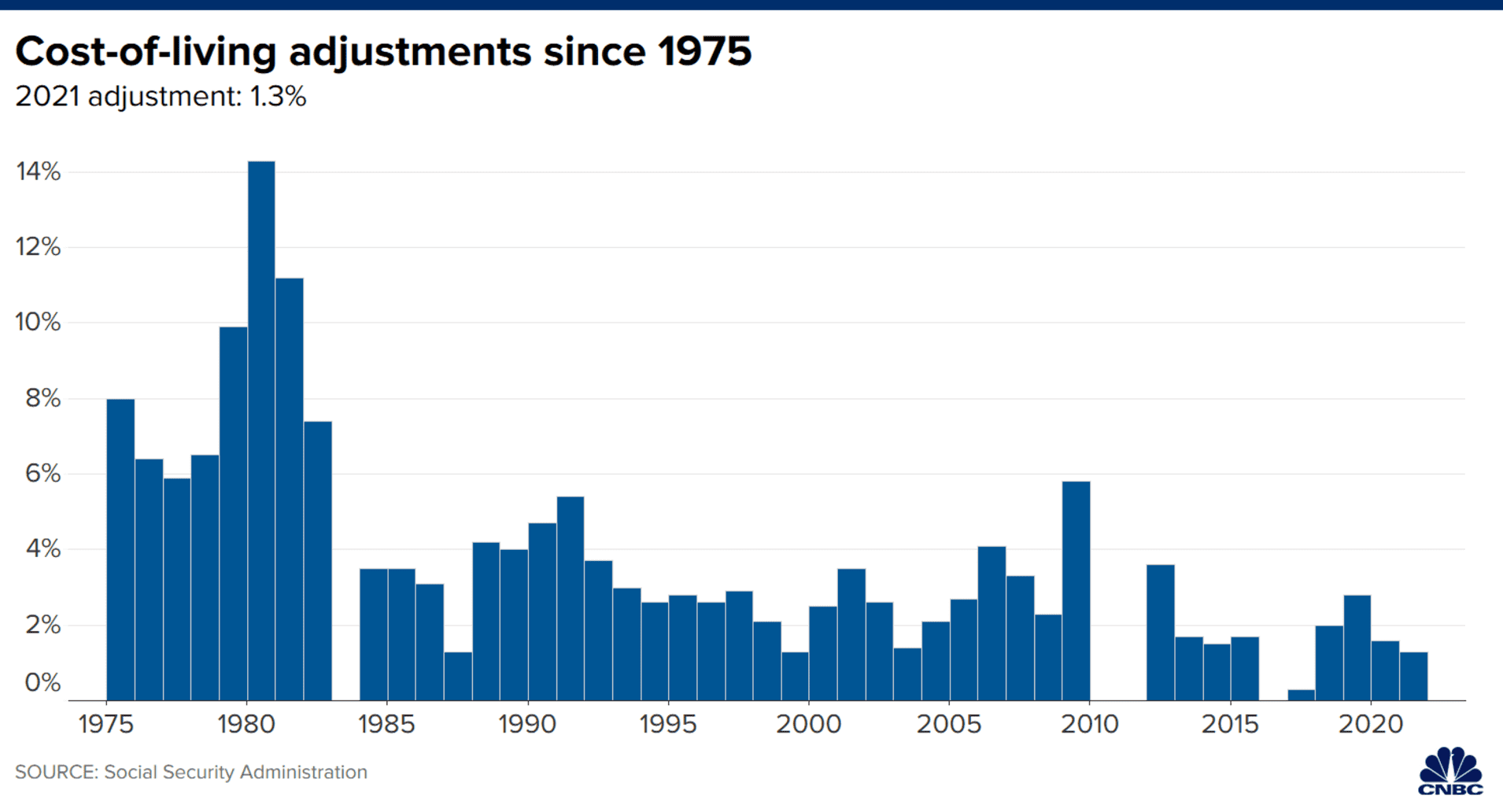
Updated Thu, Jul 15 2021 - CNBC
Lorie Konish
Key Points
The Social Security cost-of-living adjustment for 2022 could be 6.1% due to inflation, according to a new estimate.
That would be the biggest increase since 1983, according to non-partisan advocacy group The Senior Citizens League, which calculated the figure. It's also a bump up from last month's estimate, when the increase for next year was expected to be 5.3%.
The new estimate comes as the Consumer Price Index in June increased 5.4% from a year earlier, the largest gain since August 2008. Higher food and energy prices were among the culprits that helped push the inflation measure higher.
That helped push estimate the Social Security COLA for 2022 higher. That annual change is calculated based on the Consumer Price Index for Urban Wage Earners and Clerical Workers, or CPI-W.
Gasoline is particularly heavily weighted in the CPI-W, which helped to push up the COLA estimate. Many seniors are also noticing higher prices at their grocery stores, according to Mary Johnson, Social Security and Medicare policy analyst at The Senior Citizens League.
The COLA could be subject to change, as there are still three more months of data to report before the Social Security Administration determines the official number for next year.
One thing unlikely to happen during that time is any action from the Federal Reserve. Central bank Chairman Jerome Powell said on Wednesday that the Fed is still "a ways off" from changing its policy.
The Social Security COLA for 2021 was 1.3%. For many retirees, that meant just $20 more per month. Over the years, the increases have led to a loss of buying power for seniors, according to research from The Senior Citizens League.
One bill was reintroduced in Congress last week to change the way the annual COLA is calculated to better reflect costs seniors pay.
The Fair COLA for Seniors Act of 2021, proposed by Rep. John Garamendi, D-Calif., calls for changing the measure to the Consumer Price Index for the Elderly, or the CPI-E, rather than the CPI-W that is currently used.
The CPI-E may better reflect the expenses seniors face, because it is based on items that people age 62 and older tend to use, including a higher weighting for health-care costs, according to Richard Johnson, director of the program on retirement policy at the Urban Institute.
Annual cost-of-living adjustments rose by an average of 2.9% based on current methods from 1982 to 2011. The CPI-E, by contrast, increased by an average of 3.1% during that time period, according to the proposed legislation.
The co-sponsors for Garamendi's bill are mostly Democrats. In contrast, Republicans in the past have proposed moving to the so-called Chained CPI, which measures how people adjust their spending when prices go up.
Switching to the CPI-E would result in an additional increase of about 0.2 percentage points per year over the current index, according to the Urban Institute's Johnson. "Over time, that has a big impact," he said.
Estimates indicate that after 25 years, cost-of-living adjustments using the CPI-E would push benefits 5% higher.
However, today's retirees might not see much of a difference because it takes years to accumulate, Johnson said. But making the change still makes sense, he said.
"The point of having these cost-of-living adjustments is so that the purchasing power of Social Security does not erode over time," Johnson said. "If we're not using the right inflation adjuster, then benefits can erode."
While altering the way the COLA is calculated is an "obvious kind of change that we should make," according to Johnson, there is one thing that stands in the way: costs.
"It would worsen the trust funds' financial position, which is already quite precarious," Johnson said. "It seems like this type of change could become part of a larger Social Security reform effort."
President Joe Biden's campaign plans for Social Security included moving to the CPI-E. One bill previously proposed in Congress, the Social Security 2100 Act, also includes that change.